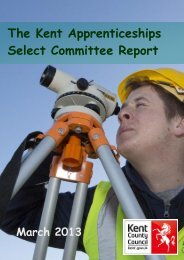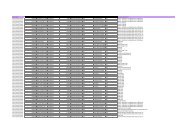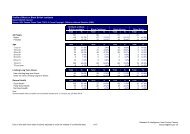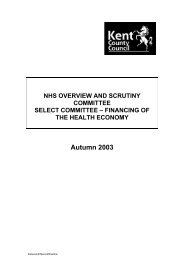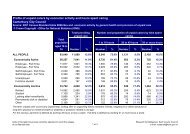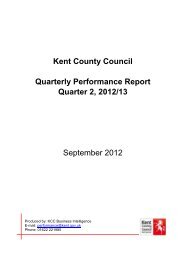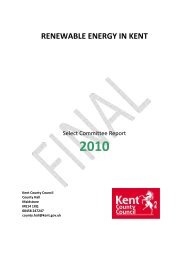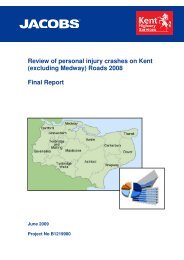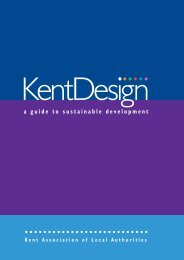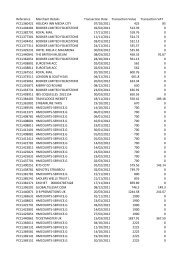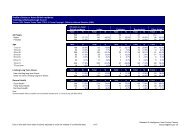Kent Design - Technical Appendix - Kent County Council
Kent Design - Technical Appendix - Kent County Council
Kent Design - Technical Appendix - Kent County Council
You also want an ePaper? Increase the reach of your titles
YUMPU automatically turns print PDFs into web optimized ePapers that Google loves.
design<br />
In Residential Shared Surfaces ground cover planting will usually be<br />
required in service strips.<br />
Where a lay-by is provided on a Residential Shared Surface, the<br />
adjacent service strip shall be hard paved, so as to provide a paved<br />
surface for persons alighting from vehicles.<br />
Where it is agreed trees can be planted within a service strip, such planting<br />
shall be agreed with the Engineer and conform with Section 2.9.4.<br />
The highway boundary associated with a service strip shall be defined<br />
by continuous 50mm x 150mm edging type EF to BS7263.<br />
2.9.4 TREES<br />
When siting new trees within a verge, visibility splay or service strip,<br />
considerable care needs to be taken regarding:-<br />
• Obstruction of visibility.<br />
• Lighting<br />
• Possible root damage to paved surfaces, pipes, services etc.<br />
• Proximity to carriageway.<br />
No new trees shall be planted within the 2.0 metre 'x' distance by 'y'<br />
distance visibility splay area at a junction. Behind this splay but within<br />
the general junction visibility splay area the limited planting of suitable<br />
species of trees may be acceptable after careful consideration of the<br />
affect of the trees on junction visibility.<br />
In forward visibility splays, the limited planting of suitable species of<br />
trees may be acceptable after careful consideration of the affect of<br />
the presence of the trees on forward visibility.<br />
Where it is agreed that trees are acceptable within visibility splays,<br />
they shall be clear stemmed for up to 2.0 metres above ground level.<br />
Trees within verges and service strips shall be set back at least 1.5<br />
metres from the carriageway adjacent to Local Distributor Roads and<br />
Industrial and Commercial Roads, and at least 1.0 metre from the<br />
carriageway. adjacent to Residential Access Roads.<br />
Trees can be underplanted with low shrubs if within the highway area.<br />
Those trees which are known to be surface rooting i.e. cherries<br />
should not be used near services or footways. Trees with large slow<br />
decomposing leaves should also be avoided at sensitive locations.<br />
The eventual branch-spread should allow for a 5.3 metres clearance<br />
between the carriageway and the lowest branches. Upright growing<br />
trees should be used where there are space problems.<br />
It is essential that tree species conform to the very vigorous requirements<br />
of the Highway Authority. Such requirements include the following:<br />
• Root Systems - Must not be surface rooting.<br />
• Stability - Must have good stability and not be prone to<br />
branch drop.<br />
• Fruits - Must not have large or messy fruits, or be<br />
copious seeders. Species that encourage aphids i.e. limes<br />
should also be avoided.<br />
• Leaf Problems - Should not have large leaves that are<br />
slow to rot.<br />
• Growth Characteristics - Need to be compatible with the<br />
highway location. Light or dappled shade is preferable.<br />
• Robust - Tolerant of disturbed ground conditions and<br />
road salt.<br />
• In Keeping - With the local character of the area, and<br />
appropriate for the soil type<br />
46<br />
<strong>Kent</strong><br />
<strong>Design</strong><br />
2.9.5 SOIL PREPARATION<br />
Subsoil in the base of tree pits shall be thoroughly broken up to a<br />
minimum depth of 150mm below the base of the pit. In tree pits trees<br />
shall be planted in an open and friable soil complying with BS 3882<br />
Premium Grade. If this is not available topsoil to BS 3882 General<br />
Purpose Grade, improved by addition three parts of non-peat based<br />
tree compost to seven parts of topsoil. Approximately 200g of slow<br />
release fertiliser per tree shall be worked into the backfill mixture.<br />
The tree pit shall be excavated to allow adequate clearance between<br />
the root ends (when fully spread) or the perimeter of the ball and the<br />
side of the pit. The size of the pit must be such as to allow for the<br />
provision of not less than 0.5m 3 of good topsoil for planting. The depth<br />
must be at least 75mm greater than the depth of the root system.<br />
In shrub areas, Premium quality topsoil to BS3882 must be spread<br />
in planting areas to a minimum depth, after settlement, of 300mm<br />
over a minimum depth of 150mm of previously loosened subsoil.<br />
This will necessitate restricting concrete haunching to kerb edgings in<br />
order that the soil space is not unnecessarily reduced.<br />
In grass seeding and turfing areas, topsoil to BS3882 shall be spread<br />
to a thickness of 100mm. The subsoil layer must be loosened to a<br />
further 150mm depth prior to the spreading of topsoil. Topsoil shall<br />
be spread to give a finished level after light consolidation 25mm<br />
above adjacent edges, hard surfaces or manhole covers.<br />
2.9.6 SHRUBS<br />
For the successful establishment of ground cover shrubs in service<br />
strips and visibility splays it is essential that the species selected<br />
conforms to the very vigorous requirements of the Highway<br />
Authority. Such requirements include the following:<br />
• Availability - Readily available in the trade to allow for<br />
planting in bulk and for replacements following<br />
disturbance by Statutory Undertakers or the Highway<br />
Authority.<br />
• Establishment - Quick establishment to provide<br />
immediate effect and reduce maintenance costs.<br />
• Root Systems - That does not interfere with underground<br />
services or adjoining surfaces.<br />
• Restricted Growth - Growth characteristics which<br />
restrict themselves to the planted area and below a<br />
height of 600mm, and with minimal pruning needs.<br />
• Wear Resistance - Tolerant of the occasional trampling.<br />
• Hardiness - Resistant to frost damage, diseases and pests<br />
and long lived.<br />
• Chemical Tolerance - To avoid damage from common<br />
chemicals used in the initial stages of establishment to<br />
control weed growth.<br />
• Non Injurious - No toxic fruit or sap, no thorns.<br />
• Visual Qualities - Neat appearance and providing an all<br />
year round effect, preferably with seasonal variations.<br />
2.9.7 SUSTAINABILITY ISSUES<br />
These should be considered when specifying planting schemes. In<br />
particular:<br />
Tree stakes should be from local renewable resources. Sweet<br />
Chestnut is ideal, as it lasts long enough to do its job with minimal<br />
preservative treatment and is also a traditional <strong>Kent</strong> product.<br />
Soil Ameliorants must be peat free.<br />
Where native species are used, stock of local provenance is desirable.



